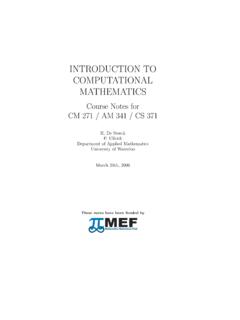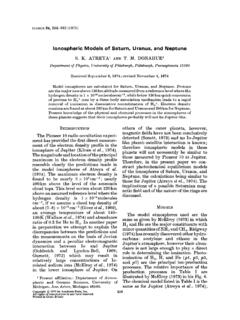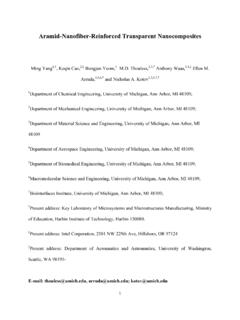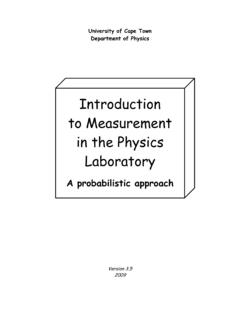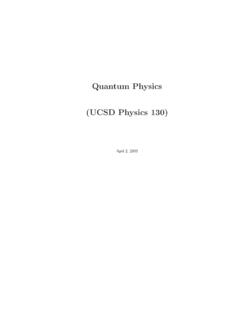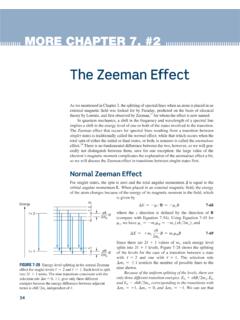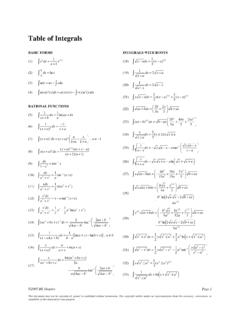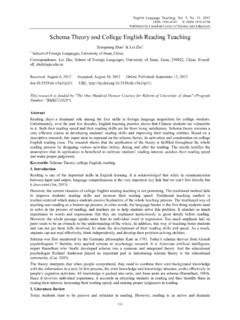Transcription of Physics 390: Homework set #5 Solutions
1 March 16, 2007 Physics 390: Homework set #5 SolutionsReading:Tipler & Llewellyn, Chapter 8 (1-5), Chapter 9 (4-6), Chapter 10 (2-8)Questions:1. It is generally more convenient whenever possible to use the Maxwell-Boltzmann distri-bution, rather than quantum statistics. Under what conditions can quantum systems bedescribed by classical statistics?Solution:Generally, classical statistics are appropriate wheneverthe particles are far enough apartthat we can regard them as distinguishable. This occurs whenthe average separation is greater thanthe de Broglie wavelength, or NV h3(3mkT)3/2 the discussion on pp. 358-9 for further Estimate the mean kinetic energy of the free electrons ina metal if they obeyed Maxwell-Boltzmann statistics.
2 How does this compare with the actualresult from applying Fermi-Diracstatistics? Why is there such a difference?Solution:According to classical statistics, a free electron with three translational degrees of freedomshould obey the equipartition theorem. At room temperatureof 300 K, the average energy wouldthen beE=32kT=32( 10 5eV/K)(300 K) = Fermi-Dirac statistics, however, we find that average energies are on the order of the Fermienergy, which are typically about 5 eV. So the classical prediction is wrong by about two orders ofmagnitude. The difference is due to the fact that electrons obey the exclusion principle, and cannotall fit in the low-lying states nearkT.
3 So most of the electrons occupy higher-energy states nearerto the Fermi energy, just like most of the electrons in a multi-electron atom are in the outer Three identical, indistinguishable particles are placedinto a system consisting of four en-ergy levels with energies , , , and eV, respectively. The total energy of the threeparticles is eV. What is the average number of particles occupying each energy level, ifthose particles are (a) bosons, or (b) fermions?Solution:To solve this problem, let s distribute the particles into the energy levels such thatEtot= 6 are three configurations of doing 6 eVConfiguration indexE1E2E3E41ooo2ooo3ooo(a) Since the particles are indistinguishable bosons, eachof the three configurations can only becounted once.
4 Therefore:n1= 3/3 = 4/3 = 1/3 = 1/3 = as required.(b) Since the particles are indistinguishable fermions, only one fermion can be put into each energylevel (the energy levels are non-degenerate). Thus, only the first configuration is :n1= 1/1 = 1/1 = 1/1 = 0/1 = as :Chapter 8: 15, 22, 33, 45 Chapter 9: 27, 35, 38 Chapter 10: 12, 17, 22, 26 Problem 8-15:From Eqn. 8-35n(E) =2 N( kT)3/2E1/2e most probable kinetic energy is found at the maximum of the distribution, wheredndE= 0 =2 N( kT)3/2 12E 1/2+E1/2 1kT e E/kT=E 1/2e E/kT 12 EkT .The maximum corresponds to the vanishing of the last vanishing of the other two factorscorrespond to a minima atE= 0 andE=.
5 Therefore,12 EkT= 0 E= 8-22:The de Broglie wavelength for anH2molecule is =hp=hp2mhEi=hp2m(3kT/2)=h , the average distance between molecules in an ideal gas is (V/N)1/3, which we can findfrom the ideal gas law:P V=nRT=NkT= (V/N)1/3= (kT/P)1 this separation to the de Broglie wavelength, we have(kT/P)1/3=h forTgivesT="P h3k(3mk)3/2#2 that the pressure remains at 1 atm = 101,000 Pa, we haveT="(101,000 Pa)( 10 34J s)3{3(2 10 27kg)}3/2( 10 23J/K)5/2#2/5= 8-33:Approximating the nuclear potential with a 3-dimensional infinite square well andignoring the Coulomb repulsion of the protons, the energy levels for both protons and neutrons aregiven byEnxnynz=(n2x+n2y+n2z)h28mL2 The ten protons will fill in the first five levels, which are the ground state (111), the three degeneratelevels of the first excited state (112, 121, 211), and one of the three degenerate levels of the secondexcited state (122, 212, 221).
6 (See the figure and discussionon p. 292). SoEF(protons) =E122=9h28mL2=9(1240 Mev fm)28( MeV/u)(2 fm)2= twelve neutrons will fill up the first six states, so they occupy the same levels as the protons,but take up two of the degenerate levels of the second excitedstate. SoEF(neutrons) = MeVas average energy of both the protons and neutrons is then (Eqn. 10-37)hEi=35EF= 31 we will see in Chapter 11, these numbers are about right fornuclear energy solution in the book is incorrect!3 Other Solution:The Fermi energyEFof a proton or a neutron isEF=h22m 38 NV 2/3=(hc)22mc2 38 2/3 NV 2 protons and neutrons in the2210Ne atom occupy a volumeV=4 3R3=4 3( fm)3= , that the value forNis 10 for protons and 12 for neutrons, because protons and neutrons aredistinguishable particles.
7 ThusEF(p) =(1240 MeV fm)22(940 MeV) 38 2/3 2/3= (n) =(1240 MeV fm)22(940 MeV) 38 2/3 2/3= ,EFis weighted mean of the proton and neutronEF= , andhEi=35EF= 8-45:(a) Assuming that each state is nondegenerate, so thatgi= 1, we needN=Xini=f0+f1=Ce0+Ce /kT=C(1 +e /kT).SoC=N1 +e /kT.(b) The average energy ishEi=1 NXiEini=0 n0+ n1N= Ce /kTN=N e /kT(1 +e /kT)N= e /kT1 +e 0,e /kT 0, sohEi 0. That is, all the particles are in the ground ,e /kT 1, sohEi /2. That is, the ground state and the excited state haveequal occupancies.(c) The heat capacity isCV=dEdT=d(NhEi)dT=ddT N e /kT1 +e /kT!=N 2kT2" (e /kT)2(1 +e /kT)2+e /kT(1 +e /kT)#=Nk kT 2e /kT(1 +e /kT)2.
8 (d) This looks like:4kT/ heat capacity is greatest whenkTis about half the size of the energy 9-27:If we regard the Br atom as fixed, then the rotational inertia of the HBr moleculeisI= the characteristic rotational energy isE0r= h22I= h22mHr20=( 10 34J s)22( )( 10 27kg/u)( nm)2(10 9m/nm)2= 10 22J = 10 rotational levels areE = ( + 1)E0r(Eqn. 9-13) for = 0,1,2.. The four lowest states haveenergiesE0= 0E1= 2E0r= 10 3eVE2= 6E0r= 10 3eVE3= 12E0r= 10 9-35:(a) The total energy of a 10 MW (=107J/s) pulse that lasts for ns isE= (107J/s)( 10 9s) = 10 2J.(b) The wavelength of the emitted light for a ruby laser is = nm, so the energy per photonisE =hc =1240 eV nm= eV,and the number of photons isn = 10 2J( eV)( 10 19J/eV)= 9-38:(a) The number of atoms in the upper state to those in the lowerstate isn(E2)n(E1)=e E2/kTe E1/kT=e (E2 E1) E1=hc =1240 eV nm420 nm= eVAtT= 297 K,kT= ( 10 5eV/K) (297 K) = eV, andn(E2) =n(E1)e 1021e 115= 2 10 29 0.
9 (b) The energy emitted in a single laser pulse is E= ( 1021) ( eV/photon) = 1021eV = 850 10-12:The number densitynof free electrons, assuming 1 electron per atom, isn= , for(a) for silvern=( g/cm3)( 1023/mo; e) g/mole= 1022/cm3.(b) for goldn=( g/cm3)( 1023/mo; e) g/mole= 1022 results are in good agreement with the experimental values from Table 10-17:(a) The Fermi energy, given by Eqn. 10-35, isEF=(hc)22mc2 3N8 V 2/3for Ag:EF=(1240 eV nm)22(511 103eV) 3( 1028m 3)8 10 9m1 nm!3 2/3= Fe:EF=(1240 eV nm)22(511 103eV) 3( 1028m 3)8 10 9m1 nm!3 2/3= eV.(b) The Fermi temperature, given by Eqn. 10-38, isfor Ag:TF=EFk= 10 5eV/K= Fe:TF=EFk= 10 5eV/K= results are in good agreement with the experimental values from Table 10-22:We use Eqn.
10 10-44,U=35 NEF+ N kTEF kT,with = 2/4. The average energy per electron isUN=35EF+ 24 kTEF copper,EF= eV (Table 10-3), so atT= 0 K we haveUN=35EF=35( eV) = 300 K,UN=35( eV) + 24 ( 10 5eV/K)2(300 K) eV!= difference from the value atT= 0 is only eV, a consequence of the fact thatT= 300 Kis very small compared to the Fermi temperature for Cu of 81,600 classical value for the average energy isUN=32kT= eV,which is far too 10-26:The wavelength of a photon that will excite an electron from the top of the valenceband to the bottom of the conduction band is =hcE=1240 eV eV= 103nm = 10




